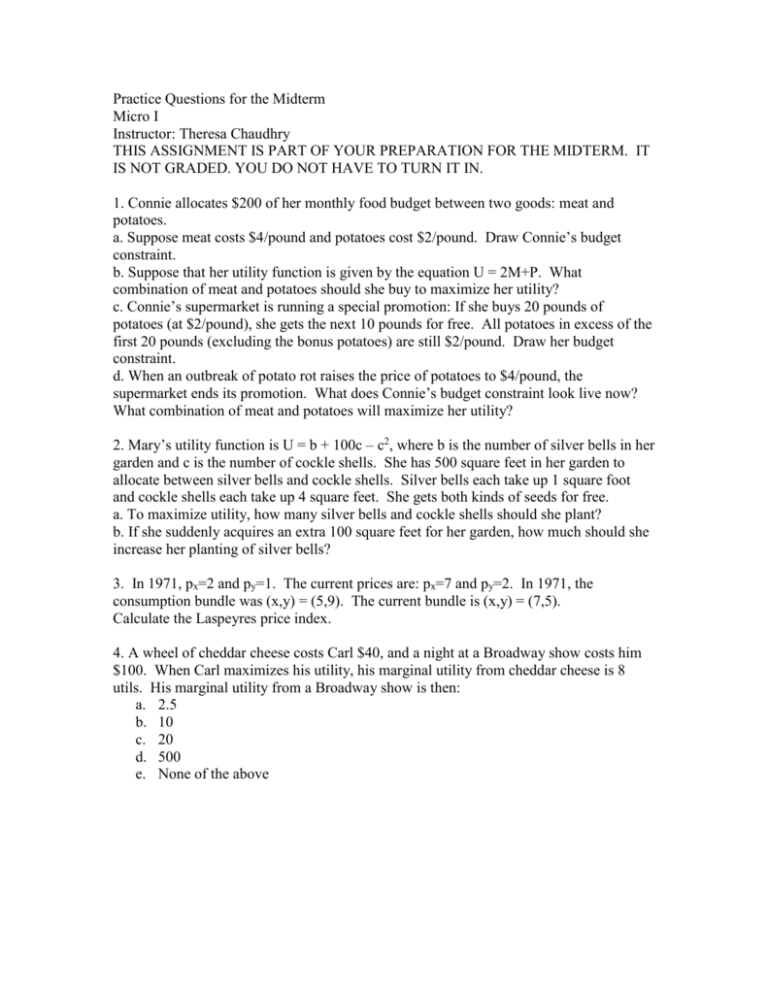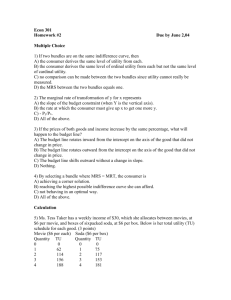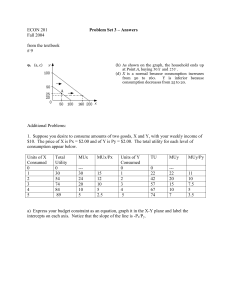Practice questions for Chapters 5, 6 and Price Indices
advertisement

Practice Questions for the Midterm Micro I Instructor: Theresa Chaudhry THIS ASSIGNMENT IS PART OF YOUR PREPARATION FOR THE MIDTERM. IT IS NOT GRADED. YOU DO NOT HAVE TO TURN IT IN. 1. Connie allocates $200 of her monthly food budget between two goods: meat and potatoes. a. Suppose meat costs $4/pound and potatoes cost $2/pound. Draw Connie’s budget constraint. b. Suppose that her utility function is given by the equation U = 2M+P. What combination of meat and potatoes should she buy to maximize her utility? c. Connie’s supermarket is running a special promotion: If she buys 20 pounds of potatoes (at $2/pound), she gets the next 10 pounds for free. All potatoes in excess of the first 20 pounds (excluding the bonus potatoes) are still $2/pound. Draw her budget constraint. d. When an outbreak of potato rot raises the price of potatoes to $4/pound, the supermarket ends its promotion. What does Connie’s budget constraint look live now? What combination of meat and potatoes will maximize her utility? 2. Mary’s utility function is U = b + 100c – c2, where b is the number of silver bells in her garden and c is the number of cockle shells. She has 500 square feet in her garden to allocate between silver bells and cockle shells. Silver bells each take up 1 square foot and cockle shells each take up 4 square feet. She gets both kinds of seeds for free. a. To maximize utility, how many silver bells and cockle shells should she plant? b. If she suddenly acquires an extra 100 square feet for her garden, how much should she increase her planting of silver bells? 3. In 1971, px=2 and py=1. The current prices are: px=7 and py=2. In 1971, the consumption bundle was (x,y) = (5,9). The current bundle is (x,y) = (7,5). Calculate the Laspeyres price index. 4. A wheel of cheddar cheese costs Carl $40, and a night at a Broadway show costs him $100. When Carl maximizes his utility, his marginal utility from cheddar cheese is 8 utils. His marginal utility from a Broadway show is then: a. 2.5 b. 10 c. 20 d. 500 e. None of the above 5. Susan has preference represented by the utility function U(x,y) = 6x + 2y. She consumes 19 units of good x and 7 units of good y. If her consumption of good x is lowered to 12, how many units of y must she have in order to be exactly as well off as before? a. 32 units of y b. 25 units of y c. 28 units of y d. 8 units of y e. None of the above. 6. David’s utility function is U(x,y) = xy. David consumes 8 units of x and 40 units of y. a. David would be willing to make small exchanges of x for y such that he gives up 5 units of y for every unit of x. b. David would be willing to trade all of his x for y as long as he gets more than 5 units of x for every unit of y he gives up. c. David lives x and y equally well, so he is always willing to exchange 1 unit of either good for more than one unit of the other d. David will always be willing to make trades at any price if he does not have equal amounts of the two goods. e. None of the above. 7. Wanda’s utility function is U(x,y) = x + 54y -2y2. Her income is 179. If the price of x is 1 and the price of y is 18, how many units of good x will Wanda demand? a. 14 b. 20 c. 26 d. 16 e. 17 8. Coke and Pepsi are perfect substitutes for Mr. Smith, and the slope of his indifference curves is -1. One day he bought 2 bottles of Coke and 20 bottles of Pepsi. (The bottles of both drinks are the same size.) Which statement is true? a. Coke is less expensive than Pepsi. b. Coke is more expensive than Pepsi. c. Coke and Pepsi cost the same. d. Mr. Smith prefers Pepsi to Coke. e. None of the above. 9. Henrietta’s utility function is U(x1,x2) = x1x2. She has diminishing marginal rate of substitution between goods 1 and 2. a. True b. False 10. At a corner solution, a consumer’s indifference curve must be tangent to her budget line. a. True b. False 11. Ben’s utility function is U(x,y) = 29xy. He has 12 units of x and 6 units of y. Will’s utility function for the same two goods is U(x,y) = 5x + 2y. Will has 8 units of x and 13 units of y. Which of these statements is true? a. Ben prefers Will’s bundle to his own, but Will prefers his own bundle to Ben’s. b. Will prefers Ben’s bundle to his own, but Ben prefers his own bundle to Will’s. c. Each prefers the other guy’s bundle to his won. d. Neither prefers the other guy’s bundle to his own. e. Since they have different preferences, there is not enough information to determine who envies whom. 12. The prices of goods x and y are each $1. Jane has $20 to spend and is considering choosing 10 units of x and 10 units of y. Jane has nice convex preferences and more of both goods is better for her. When x is measured on the horizontal axis and y is measured on the vertical axis, the slope of her indifference curve at the bundle (10,10) is -2. From these facts, we can conclude that: a. b. c. d. e. the bundle (10,10) is the best she can afford. she would be better off consuming more of good x and less of good y. she would be better off consuming more of good y and less of good x. she must dislike one of the goods. More than one of the above is true. 13. Orville has a utility function U(x,y) = (x+2)(y+1). The price of x is 1 and the price of y is 1. When he maximizes his utility subject to his budget constraint, he consumes positive amounts of both goods. Which of these statements is true? a. b. c. d. e. Orville consumes exactly as much x as y. Orville consumes one more unit of x than he consumes of y. Orville consumes one more unit of y than he consumes of x. Orville consumes two more units of x than he consumes of y. None of the above. 14. Paul’s utility function for CDs and DVDs is given by U=C1/2D1/2 . a. Sketch Paul’s indifference curves (ICs) for U=5, U=10 and U=20. Let CDs=x 1 be on the horizontal axis and DVDs=x2 be on the vertical axis. f. Let m=$200, PCD=$5/unit, and PDVD=$20/unit. Draw Paul’s budget constraint on the same graph as his ICs. g. What is Paul’s MRS at the bundle (10, 10)? (Show your work – I’m not requiring you to solve this using a particular method, but you must demonstrate the method you’ve used.) h. Suppose he buys only DVDs. How many can he buy and what is his utility? i. Solve for Paul’s utility maximizing bundle. (Again, show your work – I’m not requiring you to solve this using a particular method, but you must demonstrate the method you’ve used.) 15. Vera has only $100 a month to spend on food. She read in a government publication that she can assure her herself of an adequate diet if she consumes only peanut butter and carrots, in the ratio 2 pounds peanut butter per 1 pound carrots. a. If peanut butter costs $4/pound and carrots $2/pound, how much will she eat during the month? b. Suppose peanut butter costs rise to $5/pound. By how much would Vera have to reduce her food purchases? c. How much in food stamp aid would the government have to give Vera to compensate for the effects of the peanut butter price rise? d. Graph (and label) your responses to parts a, b, and c. Let peanut butter be on the horizontal axis. 16. Suppose in 1995, income is $80, food costs $5/unit and clothing costs $5/unit. In 2005, food costs $6/unit and clothing costs $24/unit. Let preferences be represented by the Cobb-Douglass utility function u(F,C) =F1/2C1/2. Then in 1995, then optimal bundle is F=8 and C=8. a. Calculate the Laspeyres price index b. What is the level of utility achieved in 1995? c. Calculate the new optimal bundle for 2005 that gives the consumer the same utility as in 1995. d. Calculate the ideal cost of living index









